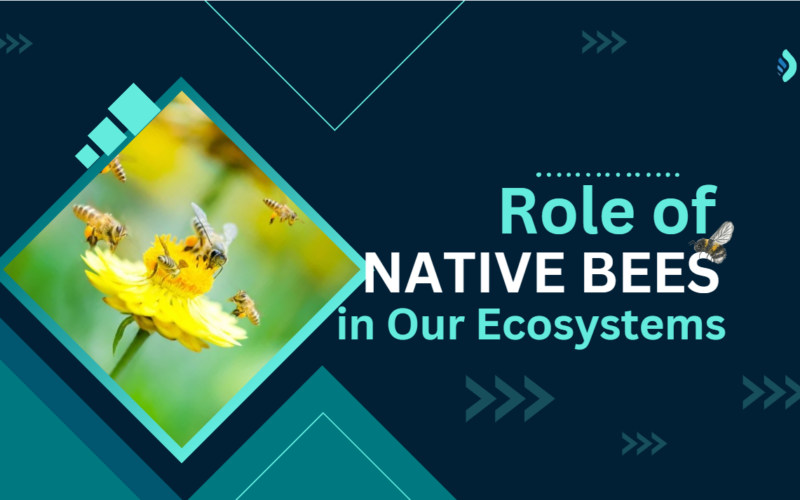Native bees are the unsung heroes of our ecosystems. Unlike the well-known honey bee, native bees often go unnoticed, yet they play a crucial role in maintaining the health and diversity of our natural environments. Their contribution goes beyond pollination, impacting agriculture, biodiversity, and even the economy. Organizations and researchers are working to understand more about native bee populations and their needs. They are developing strategies to conserve and restore habitats. To learn more about these efforts and how you can get involved, you can explore native bee conservation solutions available online and in your community.
Understanding Native Bees
Native bees are species that are indigenous to a particular region. They come in various shapes, sizes, and colors, each adapted to their specific environment. Unlike honey bees, native bees do not produce honey or live in large colonies. They are solitary creatures, with each female building her nest and raising her offspring independently.
Difference Between Native and Honey Bees
Honey bees, introduced from Europe, are social insects known for their honey production and large hives. In contrast, native bees are solitary and focus primarily on pollination. This distinction makes native bees more efficient pollinators for certain plants, especially those that evolved alongside them.
Diversity of Native Bees
The diversity of native bees is astounding. There are over 20,000 species worldwide, each uniquely adapted to their local ecosystems. From the tiny Perdita minima to the large carpenter bees, the variety is immense. This diversity ensures that a wide range of plants can be effectively pollinated, supporting robust ecosystems.
Global Distribution
Native bees are found on every continent except Antarctica. Their presence in various climates and environments showcases their adaptability and importance across different ecosystems.
Pollination Powerhouses
Native bees are among the most effective pollinators. Their unique foraging behaviors and physical characteristics make them ideal for transferring pollen from flower to flower. They often outperform other pollinators, including honey bees, in certain tasks.
Importance in Pollination
Pollination is vital for plant reproduction. Native bees enhance this process by visiting a variety of plants, ensuring genetic diversity and the survival of numerous plant species. Without their diligent work, many ecosystems would collapse.
Comparison with Other Pollinators
While butterflies and birds also play roles in pollination, native bees are more efficient. Their bodies are perfectly designed to carry pollen, and their foraging patterns ensure widespread pollination.
Native Bees and Plant Relationships
Native bees have co-evolved with plants, leading to specialized pollination strategies. Some plants rely exclusively on specific bee species for pollination, creating a delicate balance within ecosystems.
Co-evolution with Plants
Over millions of years, native bees and plants have developed mutualistic relationships. Plants offer nectar and pollen as food sources, while bees provide pollination services, ensuring plant reproduction and genetic diversity.
Specialized Pollinators
Certain native bees are specialized pollinators, meaning they only visit specific plants. This specialization can be crucial for the survival of both the bee and the plant species, highlighting the intricate connections within ecosystems.
Agricultural Impact
Native bees significantly impact agriculture by pollinating crops. Their efficiency in pollination translates into better yields and higher quality produce, benefiting farmers and consumers alike.
Role in Crop Pollination
Crops like tomatoes, blueberries, and almonds depend heavily on native bee pollination. Without these bees, the agricultural sector would face significant challenges, affecting food supply and economic stability.
Economic Benefits
The pollination services provided by native bees contribute billions of dollars to the global economy. They reduce the need for artificial pollination methods, saving costs and enhancing crop production naturally.
Threats to Native Bees
Despite their importance, native bees face numerous threats. Human activities have led to habitat loss, pesticide exposure, and climate change, all contributing to the decline of native bee populations.
Habitat Loss
Urbanization and agricultural expansion have destroyed many natural habitats, leaving native bees with fewer places to nest and forage. This loss directly impacts their survival and reproduction.
Pesticides and Chemicals
Pesticides, especially neonicotinoids, are harmful to native bees. These chemicals affect their nervous systems, leading to disorientation and death. Reducing pesticide use is crucial for their conservation.
Climate Change
Climate change alters the availability of flowers and nesting sites, disrupting the life cycles of native bees. Extreme weather events and shifting climates further threaten their survival.
Conservation Efforts
Efforts to conserve native bees are gaining momentum. Conservationists are working to restore habitats, regulate pesticide use, and combat climate change to protect these vital pollinators.
Habitat Restoration
Restoring natural habitats involves planting native flora and creating bee-friendly environments. This approach provides food and nesting sites, supporting bee populations.
Pesticide Regulation
Stricter regulations on pesticide use can mitigate their impact on native bees. Encouraging organic farming and integrated pest management practices are effective strategies.
Climate Action
Addressing climate change through sustainable practices and policies is essential. Reducing greenhouse gas emissions and protecting natural habitats can help native bees adapt to changing conditions.
Creating Bee-friendly Environments
Everyone can contribute to native bee conservation by creating bee-friendly spaces. Simple actions can make a significant difference.
Gardening Tips
Planting native flowers, avoiding pesticides, and providing nesting sites can create a haven for native bees. Gardens, even small ones, can become vital refuges.
Community Initiatives
Communities can organize bee-friendly projects, such as building bee hotels or establishing pollinator pathways. Collective efforts amplify the impact of individual actions.
How You Can Help
Everyone has a role to play in native bee conservation. Simple actions can collectively make a significant impact.
Simple Actions to Take
Planting native flowers, reducing pesticide use, and supporting local conservation projects are easy ways to help native bees thrive.
Supporting Conservation Organizations
Donating to or volunteering with conservation organizations supports their vital work in protecting native bees and their habitats.
Conclusion
Native bees are essential to the health of our ecosystems, agriculture, and economy. By understanding their roles and taking action to protect them, we can ensure a sustainable and thriving environment. Let’s appreciate these small but mighty pollinators and work together to secure their future.











